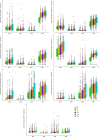IgG and IgM responses to the Plasmodium falciparum asexual stage antigens reflect respectively protection against malaria during pregnancy and infanthood
- PMID: 38764069
- PMCID: PMC11103834
- DOI: 10.1186/s12936-024-04970-7
IgG and IgM responses to the Plasmodium falciparum asexual stage antigens reflect respectively protection against malaria during pregnancy and infanthood
Abstract
Background: Plasmodium falciparum malaria is a public health issue mostly seen in tropical countries. Until now, there is no effective malaria vaccine against antigens specific to the blood-stage of P. falciparum infection. Because the pathogenesis of malarial disease results from blood-stage infection, it is essential to identify the most promising blood-stage vaccine candidate antigens under natural exposure to malaria infection.
Methods: A cohort of 400 pregnant women and their infants was implemented in South Benin. An active and passive protocol of malaria surveillance was established during pregnancy and infancy to precisely ascertain malaria infections during the follow-up. Twenty-eight antibody (Ab) responses specific to seven malaria candidate vaccine antigens were repeatedly quantified during pregnancy (3 time points) and infancy (6 time points) in order to study the Ab kinetics and their protective role. Abs were quantified by ELISA and logistic, linear and cox-proportional hazard model were performed to analyse the associations between Ab responses and protection against malaria in mothers and infants, taking into account socio-economic factors and for infants an environmental risk of exposure.
Results: The levels of IgM against MSP1, MSP2 and MSP3 showed an early protective response against the onset of symptomatic malaria infections starting from the 18th month of life, whereas no association was found for IgG responses during infancy. In women, some IgG responses tend to be associated with a protection against malaria risk along pregnancy and at delivery, among them IgG3 against GLURP-R0 and IgG2 against MSP1.
Conclusion: The main finding suggests that IgM should be considered in vaccine designs during infanthood. Investigation of the functional role played by IgM in malaria protection needs further attention.
Keywords: Plasmodium falciparum; Asexual stage; IgG; IgM; Infancy; Pregnancy.
© 2024. The Author(s).
Conflict of interest statement
The authors declare no competing interests.
Figures



Similar articles
-
Plasmodium falciparum merozoite surface antigen-specific cytophilic IgG and control of malaria infection in a Beninese birth cohort.Malar J. 2019 Jun 11;18(1):194. doi: 10.1186/s12936-019-2831-x. Malar J. 2019. PMID: 31185998 Free PMC article.
-
Associations between an IgG3 polymorphism in the binding domain for FcRn, transplacental transfer of malaria-specific IgG3, and protection against Plasmodium falciparum malaria during infancy: A birth cohort study in Benin.PLoS Med. 2017 Oct 9;14(10):e1002403. doi: 10.1371/journal.pmed.1002403. eCollection 2017 Oct. PLoS Med. 2017. PMID: 28991911 Free PMC article.
-
Humoral immune response to Plasmodium falciparum vaccine candidate GMZ2 and its components in populations naturally exposed to seasonal malaria in Ethiopia.Malar J. 2013 Feb 5;12:51. doi: 10.1186/1475-2875-12-51. Malar J. 2013. PMID: 23383869 Free PMC article.
-
Maternal malaria during pregnancy and infant mortality rate: critical literature review and a new analytical approach.J Vector Borne Dis. 2007 Jun;44(2):98-104. J Vector Borne Dis. 2007. PMID: 17722862 Review.
-
IgM, Fc mu Rs, and malarial immune evasion.J Immunol. 2010 May 1;184(9):4597-603. doi: 10.4049/jimmunol.1000203. J Immunol. 2010. PMID: 20410497 Free PMC article. Review.
Cited by
-
Antiplasmodial Activity of Probiotic Limosilactobacillus fermentum YZ01 in Plasmodium berghei ANKA Infected BALB/c Mice.J Trop Med. 2024 Dec 12;2024:6697859. doi: 10.1155/jotm/6697859. eCollection 2024. J Trop Med. 2024. PMID: 39703208 Free PMC article.
-
Current update on malaria in pregnancy: a systematic review.Trop Dis Travel Med Vaccines. 2025 May 22;11(1):14. doi: 10.1186/s40794-025-00248-1. Trop Dis Travel Med Vaccines. 2025. PMID: 40399982 Free PMC article. Review.
References
-
- WHO. World malaria report 2023. Geneva, World Health Organization, 2022. [cited 2024 Feb 7]. https://www.who.int/teams/global-malaria-programme/reports/world-malaria....
-
- Li JL, Zhou HY, Tang JX, Zhu GD, Cao J. Strategies and studies of malaria vector control in Jiangsu Province. Zhongguo Xue Xi Chong Bing Fang Zhi Za Zhi. 2020;32:459–463. - PubMed
MeSH terms
Grants and funding
- Project ANR- 2010-PRSP-012 001 - TOLIMMUNPAL/Agence Nationale de la Recherche
- Project ANR- 2010-PRSP-012 001 - TOLIMMUNPAL/Agence Nationale de la Recherche
- Project ANR- 2010-PRSP-012 001 - TOLIMMUNPAL/Agence Nationale de la Recherche
- Project ANR- 2010-PRSP-012 001 - TOLIMMUNPAL/Agence Nationale de la Recherche
- Project ANR- 2010-PRSP-012 001 - TOLIMMUNPAL/Agence Nationale de la Recherche
- Project ANR- 2010-PRSP-012 001 - TOLIMMUNPAL/Agence Nationale de la Recherche
- Project ANR- 2010-PRSP-012 001 - TOLIMMUNPAL/Agence Nationale de la Recherche
- Project ANR- 2010-PRSP-012 001 - TOLIMMUNPAL/Agence Nationale de la Recherche
- Project ANR- 2010-PRSP-012 001 - TOLIMMUNPAL/Agence Nationale de la Recherche
- Project ANR- 2010-PRSP-012 001 - TOLIMMUNPAL/Agence Nationale de la Recherche
- Project ANR- 2010-PRSP-012 001 - TOLIMMUNPAL/Agence Nationale de la Recherche
- Project ANR- 2010-PRSP-012 001 - TOLIMMUNPAL/Agence Nationale de la Recherche
LinkOut - more resources
Full Text Sources

